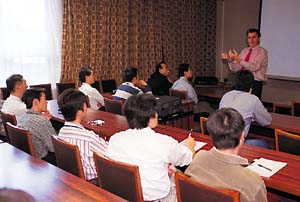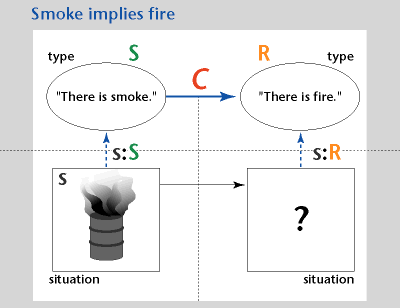|
What's the oldest information in the universe? It's the information
about the 'big bang'. Arno Penzias, one of its discoverers, thinks
of information as a substance, something you can transport. Knowledge
is quite different. Unlike information, knowledge is not something
that you can move from place to place. Knowledge is inside people:
in their heads, or in their experiences, or in the collective
activities of an organization. Can we provide a scientific, mathematical-type
understanding of information? Can we provide a clear explanation
of the difference between data, information and knowledge, and
then, can we use that understanding to design better information
and communication technologies?
The intuitive idea that we developed in the early 1980s at CSLI
was that information is what you get when you add meaning to data,
and knowledge is what you get when that information moves inside
your head - when you internalize it, when it becomes part of your
experience and it becomes available for use. Information rides
on the back of the data when we add meaning to it.
Knowledge definitely involves people, and to study it we must
use methods of the social and cognitive sciences. But what about
information? Can we develop a mathematical theory of information?
Such a theory would involve - almost certainly - mathematical
theories of language. That's why, from the very beginning, CSLI
had lots of people who did semantics, because it was understood
that you had to understand how meaning is carried by language.
I eventually realized that I was trying to find something that
was not there, because I came to believe that even for information,
you have to use methods of the social and cognitive sciences.
Knowledge is transferred from head to head. Knowledge doesn't
easily travel through information. Knowledge resides in people,
and hence knowledge management is people management.
But what about information? Where does it exist? It's not locked
in physical objects, but it's not exactly in our minds either.
It's somewhere between our minds and the physical world. How does
it arise? It's represented by things, like books, films, CDs -
all sorts of things, and they encode information by means of some
mechanism - we'll call it a 'constraint'. A constraint could be
a natural law, it could be a rule, some kind of regularity. It
could be the legal system. So the picture that we have of information
is not a simple one. It involves the world, the mind, and the
mind interacting with the world.
 |
 |
Imagine I make a statement that there are infinitely many prime
numbers; I'm a mathematician, so that's the kind of thing I might
say. What information does my statement carry? It's a true mathematical
statement and true mathematical statements don't have information
content in the sense of Shannon and Weaver's classical Information
Theory, because they have to be true. So in terms of Information
Theory, the most obvious answer is perhaps the least important
one. Another piece of information you'd get from my statement
is that I'm alive. That has greater information content than the
last piece, because I don't have to be alive. My point is, the
question, "What is the information in a signal?" doesn't have
a unique answer. It depends on these things I'm calling constraints.
What Shannon and Weaver called "information theory" actually isn't
a theory of information; it's a theory of signal or channel capacities.
In order to develop a true mathematical theory of information,
you have to develop a framework to analyze the way signals encode
or represent information. Somehow, information flows. A newspaper
article can give me information in Japan today about events that
took place in Florida yesterday. The question is, in a deep sense,
how does it?
Fred Dretzke gave the really key insight, "A signal 'S' carries
the information 'X' by virtue of 'S' being of a certain type 'T"."
This means we need agents who can classify the world according
to type before we get information. One possible signal is (for
example) the sky. The type could be one where there are lots of
black clouds. If we look up and see black clouds, we get the information
that rain is likely. So we've got the representation, the type
and the information. The point is, things themselves don't carry
information.
In the 1980's John Barwise and John Perry, who founded CSLI, introduced
a new mathematical theory called 'situation theory'. Here's a
situation. [see figure] In order for the situation s to give information
about the situation r, the s has to be of a certain type S. In
order to have information flow, the situation type S has to be
linked to some other type R by virtue of a constraint (C).
Constraints are relations that link types, and types are what
cognitive agents use to classify the world. When cognitive agents
classify the world in terms of types, they can link types together
cognitively. You don't need to see the fire because the flow through
(C) gives you the information.
Now we have mathematical objects: types and relationships. So
we have moved from the real world into the world of mathematics.
And that was the goal.
One of the conclusions you get from this research is that information
arises and flows because of the interaction of minds and things
in the world. The things in the world are situations, objects,
configurations, various kinds of systems that we build and design.
The things that make those entities informational are things in
the mind.
What I've tried to make clear is that information, unavoidably
and crucially, involves two things: systems and minds. Good design
of an information and communication technology should therefore
not merely involve both the computing sciences and the human sciences,
but should involve them at every stage of the process in an integrated
fashion. Situation theory is a mathematical theory that allows
you to do that.
(From presentation at STRL on October 19, 2001)
|

